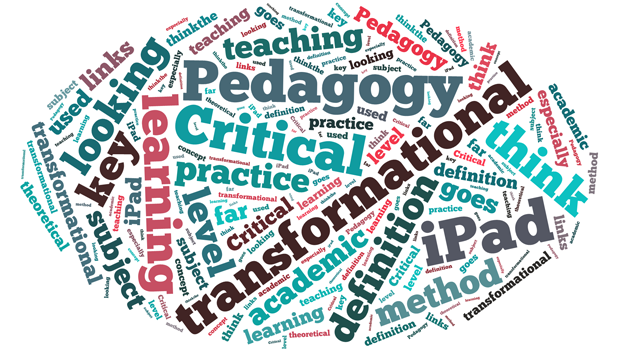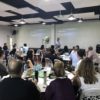
This past year preparing for the launch of iPads has been an interesting one for sure. I’ve been privileged to be able to work with amazing colleagues, students, parents and ADEs. It has provided yet again another brilliant learning curve for me.
I’ll go ahead and say it – I think the discussion on the iPad and Pedagogy needs to go further. Too many posts (and I am guilty of this too) focus on, “check out this cool app”, or “did you know the iPad can do this”; you’ve all seen them. I really feel we are past the time where we should be looking at the functionality of the iPad as a device and be looking at it in a way which ensures we are looking more at how learning can be redefined and modified through the use of the iPad.
@fraserspeirs wrote in his recent post following #ADE2012 institute in Cork about the next step for large educational organisations using iPads – he talks about the loss of networks (in a positive way), the changing of the school day because of how learning is changing and has changed in his environment. He goes on to talk about a point in time coming where there are no desktop machines for students anywhere as the mobile device caters for all needs. These things are great, but clearly Fraser and is well ahead of the learning curve than most. That said, we can learn a lot from his example.
I think a Critical Pedagogy is key when looking at iPad. Pedagogy at its definition level says “The method and practice of teaching, especially as an academic subject or theoretical concept.” Critical Pedagogy goes much further however and links far more, I think, to how the iPad should be used to transform learning (more on transformational learning later).
Critical Pedagogy is a philosophy of education by Henry Giroux as an “educational movement, guided by passion and principle, to help students develop consciousness of freedom, recognize authoritarian tendencies, and connect knowledge to power and the ability to take constructive action.”(Giroux, H. (October 27, 2010) “Lessons From Paulo Freire”, Chronicle of Higher Education. Retrieved 10/20/10).
Ira Shor defines Critical Pedagogy as
“Habits of thought, reading, writing, and speaking which go beneath surface meaning…”
…and this, surely, is what we want our students to achieve with their learning, supported by the iPad.
How does this take place though? How do students achieve this learning state through their leadership in the classroom by teachers?
Proponents of Critical Pedagogy go on to say:
“Critical Pedagogy includes relationships between teaching and learning. Its proponents claim that it is a continuous process of what they call “unlearning,” “learning,” and “relearning,” “reflection,” “evaluation,” and the impact that these actions have on the students, in particular students whom they believe have been historically and continue to be disenfranchised by what they call “traditional schooling.””
This I believe is key in ensuring success in how new technology, in this case iPads, can be used in education to bring about transformational learning.
@oldandrewuk (and I can’t believe I’m including him in a post about progressive, new world learning and education but here goes…) recently said in a tweet:
“Does your school have a member of SMT or senior teacher in charge of “teaching and learning”? Makes you wonder what the others are for.”
He has a point here, in that all teachers in a school are in charge of all of the teaching and learning that goes on within their educational setting. What he misses though is the importance of those teachers being challenged, supported and provided with skill sets that enable them to develop their own Critical Pedagogy; that comes from the leadership he mentions. Just as our learners develop over time and as such require new and innovative techniques to engage, inspire and support with their learning, so do teachers need to continue learning, both in terms of the skills they have and in the techniques they employ in the classroom. This is where ideas such as the SAMR model (among others) put forward by Ruben Puentedura can play a massive part.
Teachers are professionals and have the skills, technique and experience to create engaging lessons that can lead to outstanding learning and teaching; when dealing with new technology however, some teachers don’t. As such there is a need to think carefully about how they use their technology and the technology in the hands of the students in their lessons. It is important that teachers are provided with the toolkit to ensure transformational, or has he calls it ‘Modification’ or ‘Redefinition’, learning and tasks can be created by staff to ensure the Critical Pedagogy takes place.
I’m looking forward to learning more and working further with inspiring colleagues to discover Critical Pedagogies to support transformational learning. I can’t wait.
Further reading:
http://www.hippasus.com/rrpweblog/
http://www.jisc.ac.uk/digiemerge
http://www.jisc.ac.uk/whatwedo/programmes/elearning/digilifelong.aspx
http://www.jisc.ac.uk/whatwedo/programmes/elearning/developingdigitalliteracies.aspx
http://steve-wheeler.blogspot.co.uk/2012/05/ipad-or-ifad.html
http://speirs.org/blog/2012/7/20/the-2012-ade-institute.html
















This was a really interesting read Mark. I think we should always have the pedagolocial influences in mind whatever medium we use in teaching & learning. It is even more necessary now that there may be some in the profession who think about the new ‘toys’ to play with.
Completely agree Julia – with the kind of investment going on here, we should be asking important questions every time we want to use (any) technology in the classroom.
This has been rattling in my head for the last couple of days. Like you, I see so many workshops being offered on “get this app” or “apps for ____”. There’s no starting discussion about pedagogy, inquiry, or student choice. My concern is that iPads become a “quick fix” because educators don’t feel the need to learn about the process of building a website (i.e. wiki,tumbler) because they can just use an app that looks cool, looks like the students are engaged and looks like they are using technology.Like a textbook- it’s been built already and hey, it works.
At the base, foundation, of integrating technology is a pedagogy that the technology is a tool, not the focus, and that students have choices about which technology tool they are using to best answer the inquiry. With this, then its important that classroom teachers are following suit with iPad integration. If multiplication is being learned then multiple apps are introduced and the student chooses what is best for their learning personality.When students are creating a project they are still offered choice about their research and how they build their assignment. Perhaps instead of “app for that” it should be “there could be an app as well as other tools”.
Thanks for the brain share. My brain feels much better now. Well put together post with research and given background.
I’m sure what we’ll find over time is that those schools that do ask the questions about learning will be those that are successful with their edtech initiatives, those that don’t will simply pay lip service. Thanks for commenting.
Pleased that you have gone down this road as we certainly need more of a focus on learning. I look forward to reading your plans for next year!
Hi Mark, thanks for introducing me to the concept of Critical Pedagogy.
I agree with your central premise (according to my interpretation) that we should look beyond the shiny new toy and consider more deeply how we can use the iPad to transform the processes of teaching and learning.
Do you have any practical ideas or real-world examples illustrating how this might be done?
Love the post and the links. Have you got any further with developing your critical pedagogy? As someone just starting out with an iPad it’s great to read and learn from others who are are further down the road.
I am glad you are raising this. Too often the technology is far ahead of the pedagogy and working out how to use it for best advantage. One area that I am confident iPads can change pedagogy is in instilling the concepts of drafting, editing & redrafting until the work is of the highest possible standard. Something expected in the real workplace, but not always expected in schools. Keep up the great work!